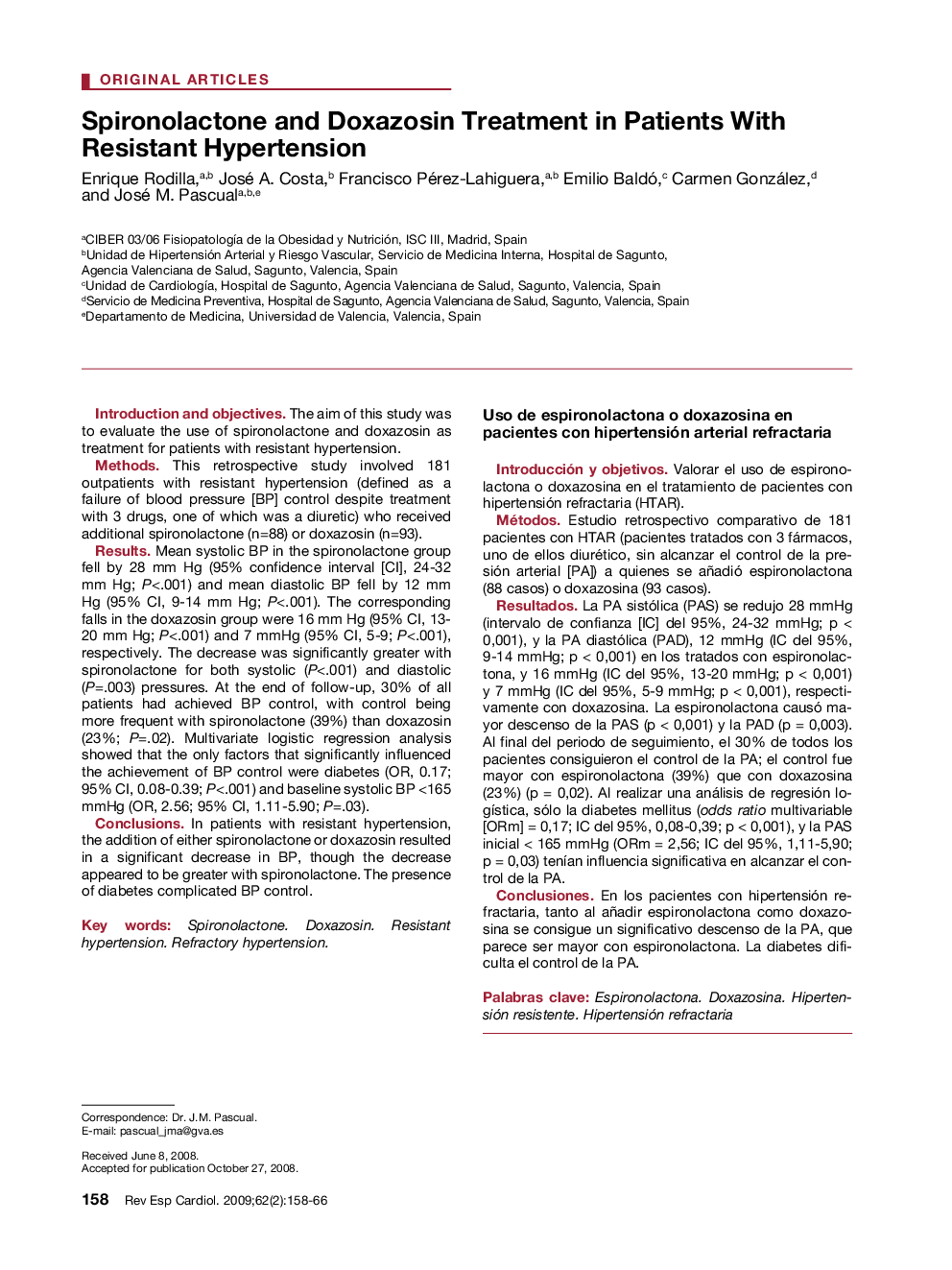| Article ID | Journal | Published Year | Pages | File Type |
|---|---|---|---|---|
| 3019162 | Revista Española de Cardiología (English Edition) | 2009 | 9 Pages |
Introduction and objectivesThe aim of this study was to evaluate the use of spironolactone and doxazosin as treatment for patients with resistant hypertension.MethodsThis retrospective study involved 181 outpatients with resistant hypertension (defined as a failure of blood pressure [BP] control despite treatment with 3 drugs, one of which was a diuretic) who received additional spironolactone (n=88) or doxazosin (n=93).ResultsMean systolic BP in the spironolactone group fell by 28 mm Hg (95% confidence interval [CI], 24-32 mm Hg; P<.001) and mean diastolic BP fell by 12 mm Hg (95% CI, 9-14 mm Hg; P<.001). The corresponding falls in the doxazosin group were 16 mm Hg (95% CI, 13-20 mm Hg; P<.001) and 7 mmHg (95% CI, 5-9; P<.001), respectively. The decrease was significantly greater with spironolactone for both systolic (P<.001) and diastolic (P=.003) pressures. At the end of follow-up, 30% of all patients had achieved BP control, with control being more frequent with spironolactone (39%) than doxazosin (23%; P=.02). Multivariate logistic regression analysis showed that the only factors that significantly influenced the achievement of BP control were diabetes (OR, 0.17; 95% CI, 0.08-0.39; P<.001) and baseline systolic BP <165 mmHg (OR, 2.56; 95% CI, 1.11-5.90; P=.03).ConclusionsIn patients with resistant hypertension, the addition of either spironolactone or doxazosin resulted in a significant decrease in BP, though the decrease appeared to be greater with spironolactone. The presence of diabetes complicated BP control.
Introducción y objetivosValorar el uso de espironolactona o doxazosina en el tratamiento de pacientes con hipertensión refractaria (HTAR).MétodosEstudio retrospectivo comparativo de 181 pacientes con HTAR (pacientes tratados con 3 fármacos, uno de ellos diurético, sin alcanzar el control de la presión arterial [PA]) a quienes se añadió espironolactona (88 casos) o doxazosina (93 casos).ResultadosLa PA sistólica (PAS) se redujo 28 mmHg (intervalo de confianza [IC] del 95%, 24-32 mmHg; p < 0,001), y la PA diastólica (PAD), 12 mmHg (IC del 95%, 9-14 mmHg; p < 0,001) en los tratados con espironolactona, y 16 mmHg (IC del 95%, 13-20 mmHg; p < 0,001) y 7 mmHg (IC del 95%, 5-9 mmHg; p < 0,001), respectivamente con doxazosina. La espironolactona causó mayor descenso de la PAS (p < 0,001) y la PAD (p = 0,003). Al final del periodo de seguimiento, el 30% de todos los pacientes consiguieron el control de la PA; el control fue mayor con espironolactona (39%) que con doxazosina (23%) (p = 0,02). Al realizar una análisis de regresión logística, sólo la diabetes mellitus (odds ratio multivariable [ORm] = 0,17; IC del 95%, 0,08-0,39; p < 0,001), y la PAS inicial < 165 mmHg (ORm = 2,56; IC del 95%, 1,11-5,90; p = 0,03) tenían influencia significativa en alcanzar el control de la PA.ConclusionesEn los pacientes con hipertensión refractaria, tanto al añadir espironolactona como doxazosina se consigue un significativo descenso de la PA, que parece ser mayor con espironolactona. La diabetes dificulta el control de la PA.
